Dear Friends,
Click the link to view the images.
http://www.williamhenry.net/art_gentleheart.html
Be Well.
David
THE SERAPHIC ECSTACY OF SAINT FRANCIS AND HIS TRANSFORMATION INTO THE SECOND CHRIST
By William Henry
Since my trip to Assisi, Italy in April, 2010 I have become infatuated with the story of Saint Francis, the 13th century Catholic ascetic, whose life arc took him from a life of wealth and privilege to self chosen material poverty and on to the highest spiritual heights, even becoming known as “Jesus’ brother” and the Second Christ. This title was bequeathed upon him when he became the first person to receive the stigmata, the five wounds of the crucified Christ. This happened through a profound mystical encounter with an apparition of Jesus as a seraphim angel who beamed five rays of light into Francis’s flesh. I devote two chapters of my new DVD presentation, SOUL RISING, to an exploration of the seraphim and the extraordinary imagery depicting this soul rising encounter and thought I would offer an introduction here.
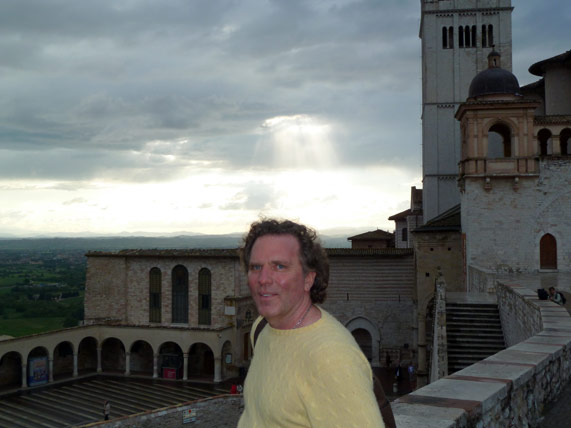
The light of Assisi embraces one upon arrival. One has to go to actually absorb the Divine feel and true power of this very special place
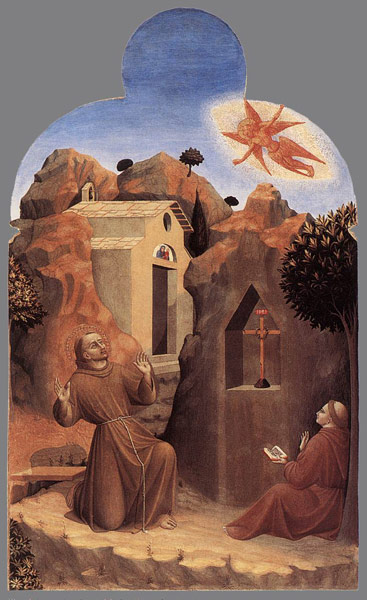
The Stigmatization of St Francis, Sassetta, National Gallery, London.
1437-44
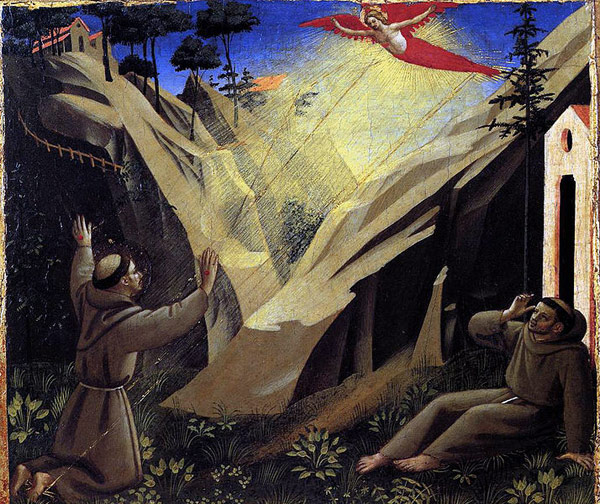
The Stigmatization of Saint Francis. Fra Angelico. Golden rays extend from the red winged Jesus as a Christ Angel directly to Francis
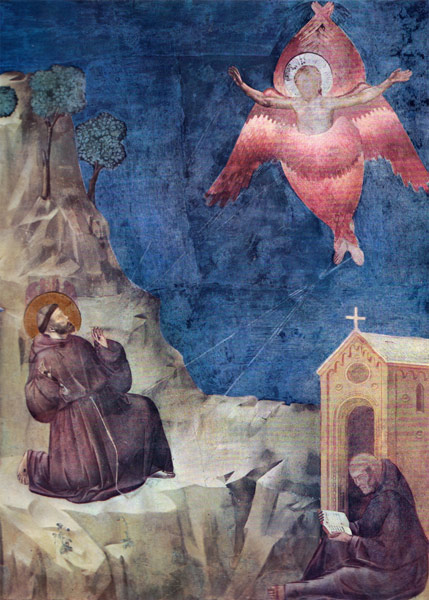
Giotto’s Stigmata of Francis, Assisi, Italy
CRUCIFIED BY DESIRE?
Recently, a friend brought me a copy of Parabola magazine. She thought I would be interested in Matthew J. Sills insightful article “Crucified By Desire: The Stigmata of Saint Francis and Desire for God.” My friend was right, but for a different reason than she might have thought.
As Sills notes, Francis was understood by his contemporaries to be someone completely taken over and transformed by his spiritual desire to link with Christ. It was his desire, say some observers, rather than a profound mystical experience with an apparition of Jesus that transformed Francis and caused the stigmata wounds. (Of course, some believe the gentle holy man’s ‘legendary’ physical ailments were due to malaria and an eye infection contracted in Egypt.)
The likely source for this linkage is THE REMEMBRANCE OF THE DESIRE OF A SOUL, written by Thomas of Celano soon after the death of Francis. Thomas recounts Francis’s vision of Jesus speaking to him from the Byzantine image of a crucified Jesus at San Damiano, a dilapidated church near Assisi. Christ is alive on the crucifix. His eyes are wide open, as if contemplating his ascension, which is portrayed just above his head. The voice from the crucifix commanded Francis to “go rebuild My house.” As a result of this vision Francis went about repairing the church at San Damiano and reforming the Catholic Church.
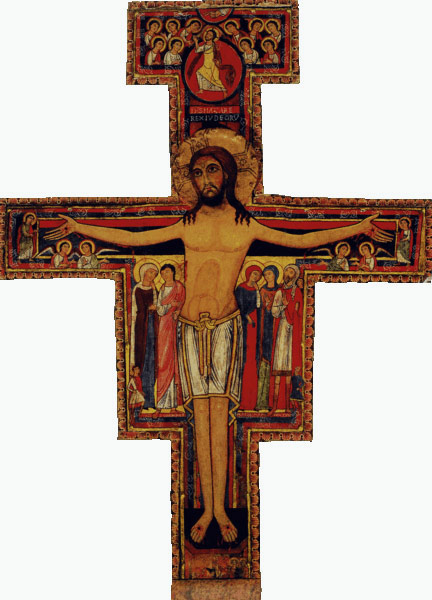
San Damiano crucifix that spoke to Francis
Thomas says soon after the vision (which is thought to have occurred in 1205) Francis’s body began to change. “From that time on, compassion for the Crucified was impressed into his holy soul. And we honestly believe the wounds of the sacred Passion were impressed deep in his heart, though not yet on his flesh.”
It is clear that Thomas believed that the seeds of the stigmata were planted in Francis’s gentle heart at the moment the Crucifix spoke and would later manifest/germinate in his body as the stigmata after Francis’s encounter with Jesus as a seraphim. But that happened later.
In 1209 Francis took a respite from rebuilding churches around Assisi, gathered a small group of followers and courageously headed to Rome to seek papal authority from Pope Innocent III to launch a new monastic order based on piety, poverty and service. In stark contrast to the powerful pope, who in July, 1209, launched a monstrous genocidal attack on the ‘heretical’ Cathars of Southern France, exterminating as many as one million men, women and children, Francis was humble and selfless, and becoming widely known for living a godly life in Assisi. Prior to his arrival, Innocent had a dream in which he saw a humble man dressed in a robe supporting the Lateran basilica in Rome. Innocent approved Francis’s request. Fed by his friend, Saint Clare, Francis opened the doors to a new order of the Church. This one was open to heretics.
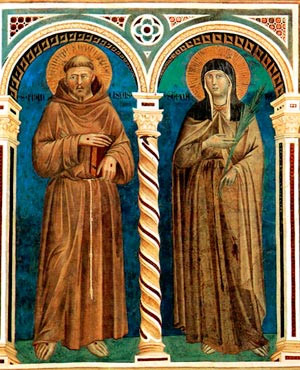
Francis and Clare. A son is born to the world." With these words, in the Divine Comedy (Paradiso, Canto XI), the greatest Italian poet, Dante Alighieri, alludes to Francis' birth, which occurred at the end of 1181 or the beginning of 1182, in Assisi. In the Divine Comedy, Dante describes Assisi as the Orient, the place where the sun rises (Canto XI Paradiso, 52-54). It is within this mediaeval context of cosmology that we have to understand the life and times of Francis of Assisi and of Clare, his "pianticella", or little plant.
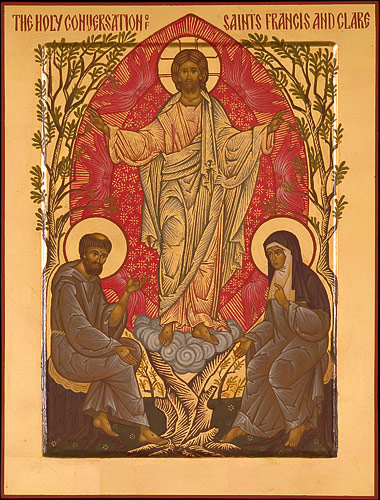
Icon of The Holy Conversation of Saints Francis and Clare. Marek Czarnecki. Commissioned by the Holy Trinity Franciscan Friary, Harlan KY. An original prototype, designed to illustrate an event from the saints' lives. Francis and Clare would retire to the woods near Assisi to converse with each other. The villagers of Assisi, seeing a red glow over the forests ran with buckets of water to douse what they assumed was a fire. Instead, they found Francis and Clare, seated in a clearing, rapt in conversation surrounded by a holy fire. The icon shows the fulfillment of Christ's promise in the gospel: "Where two or more are gathered in my name, I am there with them". The figure of the Risen Christ is in their midst, blessing and connecting them from within a red mandorla of seraphs.
As I discuss in detail in SOUL RISING, I am utterly fascinated by the concept that a piece of art, in this case a crucifix, could transmit a holy message to Francis.
Additionally, I wonder if it is possible that an additional layer of mystical or sacred energy was also transmitted to Francis through the San Damiano Crucifix.
Another biographer of Saint Francis, Bonaventure of Bagnoregio, lends support for this, writing in THE MAJOR LEGEND OF SAINT FRANCIS that, through the stigmata, the “true love of Christ transformed the lover INTO HIS IMAGE.”
One needs to analyze their own heart and what happens to their heart when they truly love something or someone to comprehend the statement, “The true love of Christ transformed the lover INTO HIS IMAGE.”
Our question is whether or not it is possible for the "True Love" frequency of Christ to have been transmitted through the painting of a crucified Jesus.
Art, especially sacred art, has extraordinary, even supernatural, power. Saint Catherine of Siena received the stigmata from a crucifix. I saw our Lord fastened upon the cross coming down towards me and surrounding me with a marvelous light...Then there came down from the holes of his blessed wounds five bloody beams, which were directed towards the same parts of my body: to my hands, feet, and heart. This was how, according to legend, Saint Catherine of Siena described receiving the stigmata.
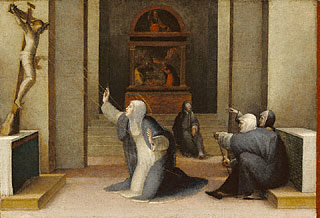
Saint Catherine receiving the stigmata in five rays beaming from a painting of a crucified Jesus. Domenico Beccafumi. 1513-1515. Getty Museum
The basic premise of palmistry is that what is in the mind, manifests in the palms of the hands. Psychologist Dr. Mario Martinez, who studied stigmatics for the Vatican, states in his theory of Biocognition that “where the mind goes, the biology follows.” He documented the case of a woman in California who exhibited the stigmata wounds after obsessively reading about the Crucifixion.
From this we may deduce that it is possible that Francis’s faith in and desire (obsession?) to be like/with the crucified Jesus alone sparked the bodily transformation. Additionally, his reflection on the True Love of Christ (rather than his suffering) could have transformed him into his image.
However, according to the story of Saint Francis, there was indeed another force involved. An apparition of Jesus as a seraphim angel appeared to Francis, and in a moment of seraphic ecstacy, ‘beamed’ him the stigmata wounds.
JESUS APPEARS AS A SERAPHIM
As the story goes, during the Lent of 1224, Francis was meditating on Mount Alverna, near his home in Assisi. His mind and heart tuned, as he frequently did, upon the suffering of Christ. While pouring out his love for Him, we are told, Francis beheld the crucified Christ borne aloft by six wings (as a seraphim). In a moment of seraphic ecstasy, he who had sought to imitate Christ in all things, actually received the marks of crucifixion on his body.
Observers described Francis’s wounds as “nail-like…round and black, standing clear of his flesh.” His side appeared to have been lanced. During the days that followed his clothing was soaked in blood. The marks remained until his death and reportedly caused him great pain. His hands and feet were bandaged because the marks caused him so much pain.
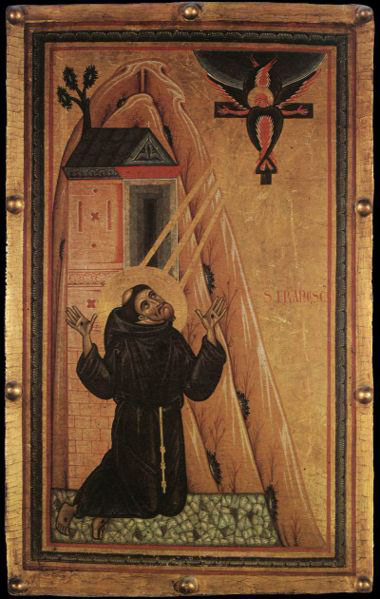
SERAPHIC ECSTACY is the term I use for being ‘beamed’ by rays of golden light from Jesus as a seraphim angel
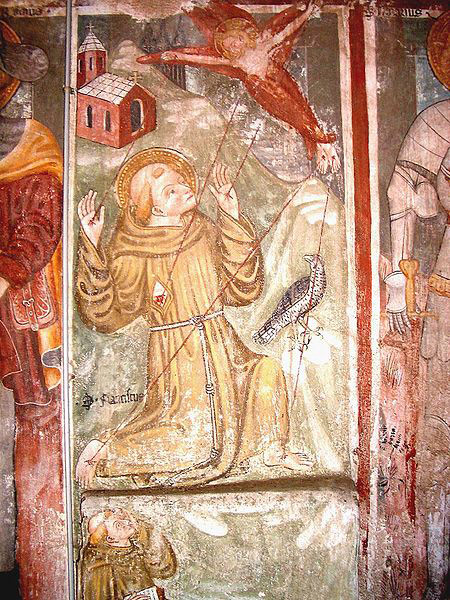
St. Francis of Assisi receives the stigmata , fresco, XV century, Caltignaga, Chiesa dei Santi Nazzaro e Celso (Sologno)
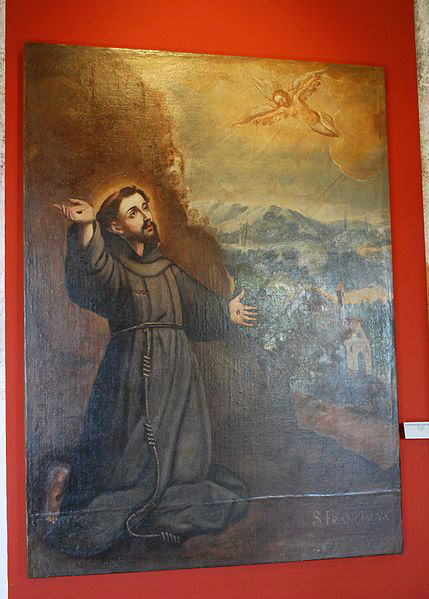
The Stigmata of Francis of Assisi" from 18th century by unknown author at the Viceregal Museum of Zinacantepec, Mexico State
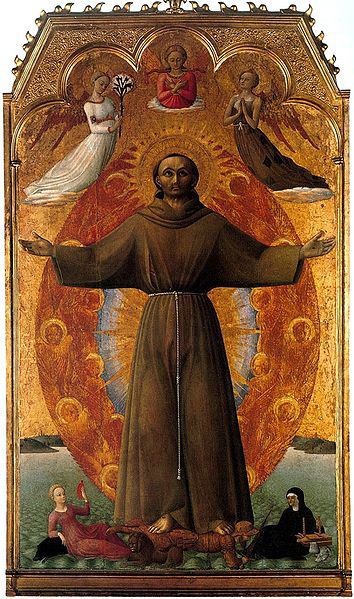
The Ecstacy of St. Francis, Sassetta. He stands in a radiant gateway surrounded by red seraphim angels
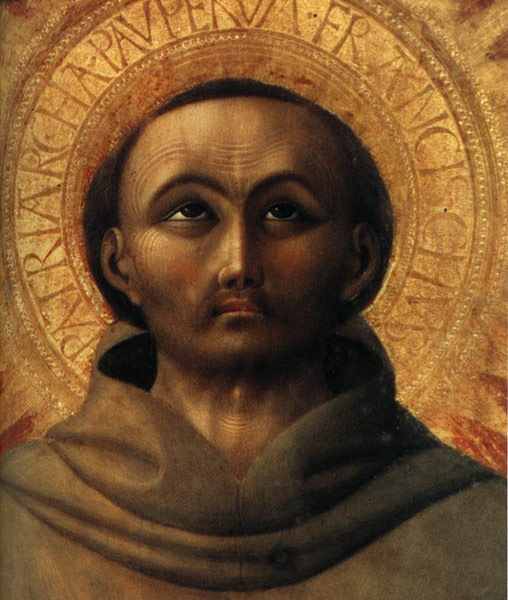
Detail of the The Ecstacy of St. Francis
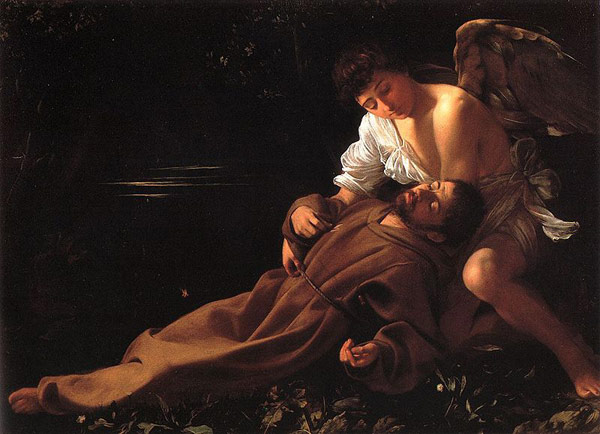
Caravaggio, St. Francis in Ecstasy c. 1595 Oil on canvas,
Wadsworth Athenaeum, Hartford, Connecticut. Francis swoons in ecstasy as an angel supports him. With one eye open, the saint seems to see something hidden from us
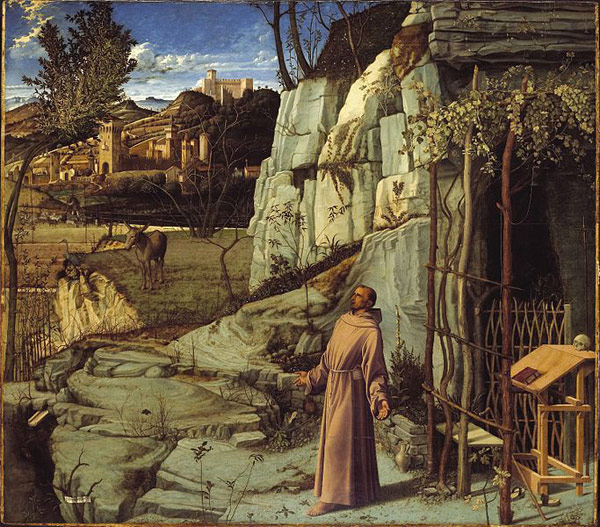
Giovanni Bellini, St Francis in Ecstasy, 1480-85, the Frick Collection, New York. Francis stands barefoot (he’s on sacred ground) with his heart open to the mysterious light emanating from the upper left-hand corner
For some, accepting this story requires too large a leap of the imagination. Church authorities have not recognized St. Francis’s stigmata as “divine intervention”. Pope Benedict XIV (1740-1758) said he was "doubtful." St. Francis de Sales (1567-1622) at first believed the marks were the result of heavenly action but later came to judge them as "a product of strong compassion in a person thinking about Jesus' suffering." Pope Pius (1846-1878), like many of his predecessors, believed that St. Francis' stigmata were "historically certain but not an article of faith." The Church's opinion is that this phenomenon occurs only in ecstatics, persons in a state of "ecstasy," reportedly a common denominator in all stigmata claims.
Ecstasy is described as an intensely emotional state in which rational thought and self-control are absent. It is a late 14th century word meaning “in a frenzy or stupor, excited.” It’s from the Greek ekstasis, meaning “entrancement.” Ecstasy is further defined as (http://www.dictionary.net/ecstasy):
The state of being beside one's self or rapt out of one's self; a state in which the mind is elevated above the reach of ordinary impressions, as when under the influence of overpowering emotion; an extraordinary elevation of the spirit, as when the soul, unconscious of sensible objects, is supposed to contemplate heavenly mysteries.
Some are uneasy with the implications of this account. It raises profound questions, beginning with exactly how did Francis enter the transformative state of ecstasy, and why did Jesus appear as a winged angel? I shall propose an answer to the latter question here.
THE SERAPHIM
As I discuss in SOUL RISING, the term Seraphim means “winged and/or fiery serpents”. They are the highest order of angels and are considered to be beings of pure light and pure love. They dwell at the Throne of God. However, they can manifest in our world. It is said that they shine so bright that any, save for the pure of heart, would be incinerated in their presence.
According to Renaissance thought, the Seraphim are a different type of human being, a fully transfigured one. Their bodies are immortal bodies of light and are therefore able to hold the highest frequencies of love and light. We can become Seraphim by meditating exclusively on the love of the Creator, say Renaissance thinkers.
Seraphim are portrayed in Christian art surrounding the Throne of God, guarding the (Star) Gate of Eden and at the birth and death of Jesus. On occasion they are shown on the Cross of crucifixion or with Jesus gently cradling one. It is unheard of to see the Resurrected Jesus portrayed as a Seraphim, except in the story of Saint Francis.
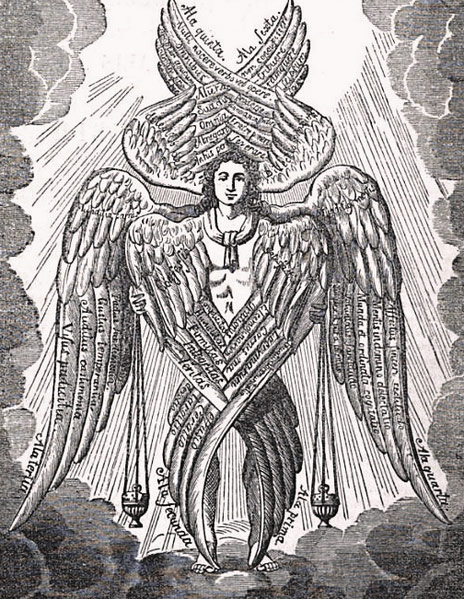
A seraphim from Migne's Patrologia Latina
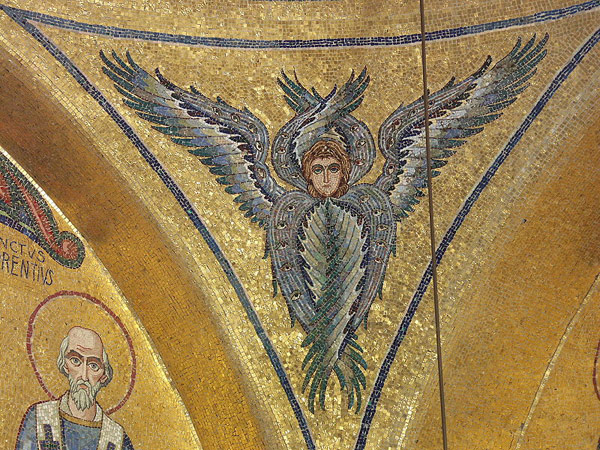
Seraphim. Mont Sainte-Odile, Alsace, France
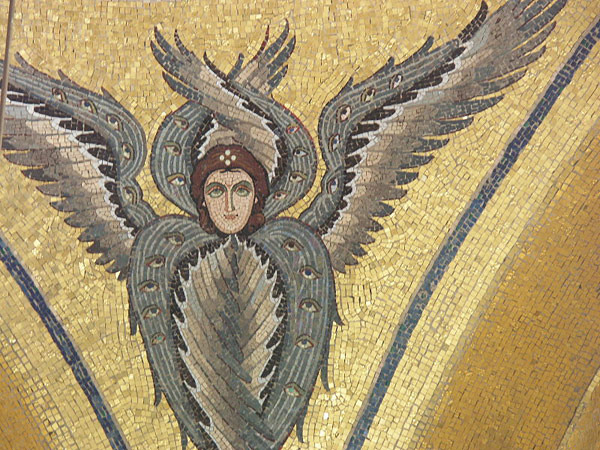
A smiling seraphim
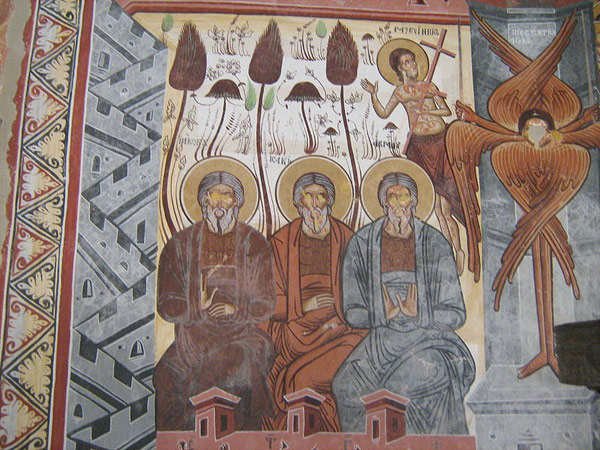
Fresco depicting Paradise guarded by a seraph. The long bird legs are intriguing
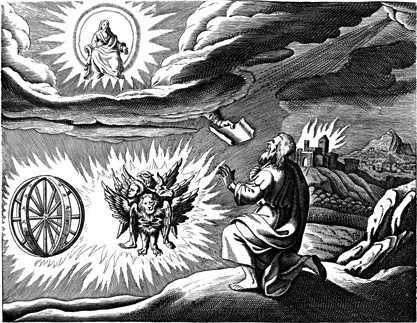
A seraphim appeared in Ezekiel’s vision of the “throne chariot” of God, 1670
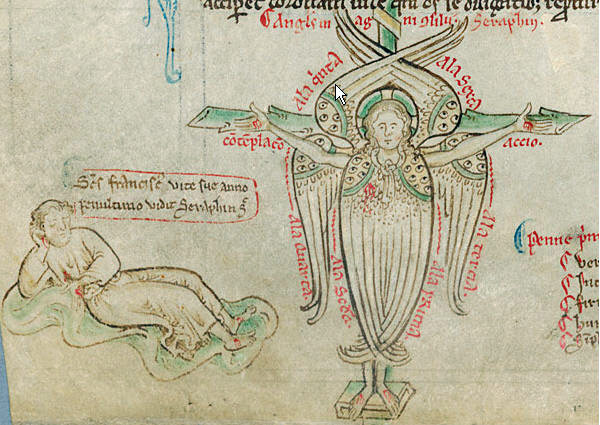
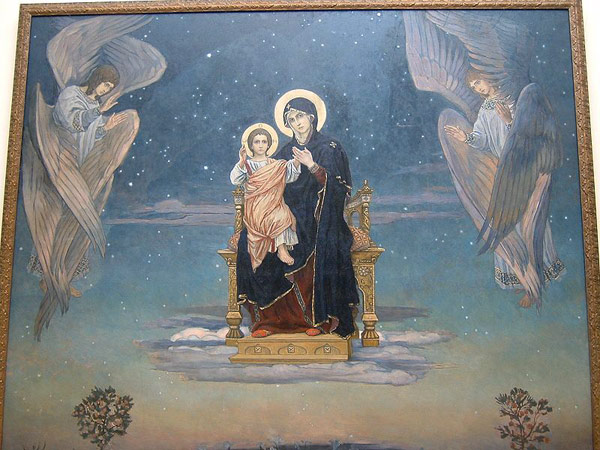
Vicktor Vasnetsov, Russian Museum. The seraphim levitate on either side of the Throne of Jesus
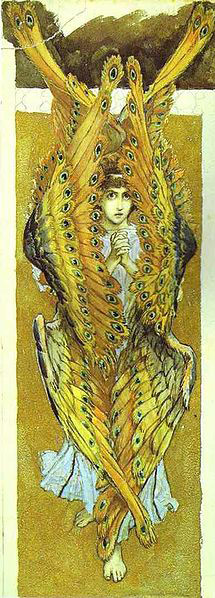
Seraphim. Vicktor Vasnetsov, Russian Museum
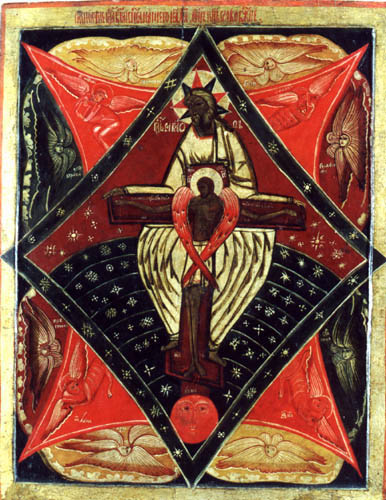
A seraphim on the Cross of Crucifixion
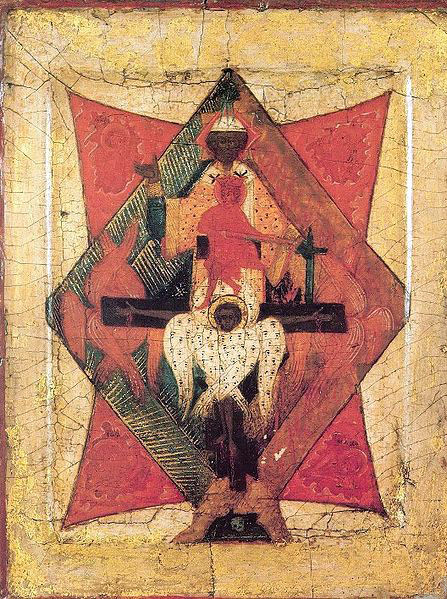
Jesus/Seraphim and the Cross
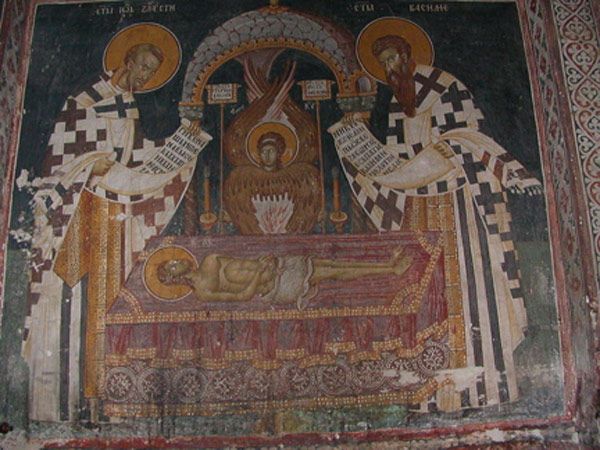
A seraphim stands at the gate between worlds and watches over the entombed Jesus
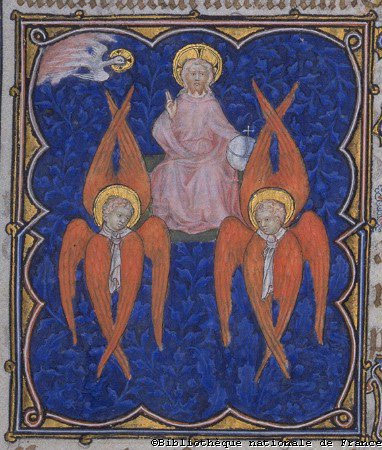
The Divine Throne flanked by the red-winged seraphim
SERAPHIC ECSTACY AND THE RAINBOW BODY
In SOUL RISING I present my hypothesis of the connection between the seraphim and the Tibetan lamas who have achieved the Rainbow Body of light and ascension into a higher order of being. In Tibetan art lamas who have entered into the Rainbow Body of light are shown with vortex-like bodies composed of swirling or spinning five-rayed or five-colored colored rainbow light. By raising the vibration of the soul, they have dissolved the elements of the human body into pure energy that manifests as five rays or bands of light.
Jesus is considered to be a being of pure light and pure love. He is shown surrounded by a rainbow in Resurrection art and on a rainbow throne in Last Judgment scenes. This is the Rainbow Resurrection Body of Christianity and, I propose, it is the same as the Rainbow Body of light and the higher frequency body of the seraphim. Additionally, the five stigmata beams or rays coming from Jesus correspond to the five rays of the Rainbow Body of light.
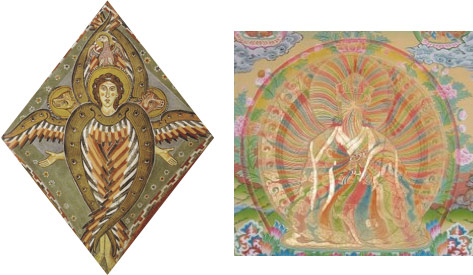
The twisting or vortex-shaped bodies of the seraphim suggest rotation and match the swirling or twirling, and liquid-like, Rainbow Body of light. This is the pure form in which the Next Humans appear
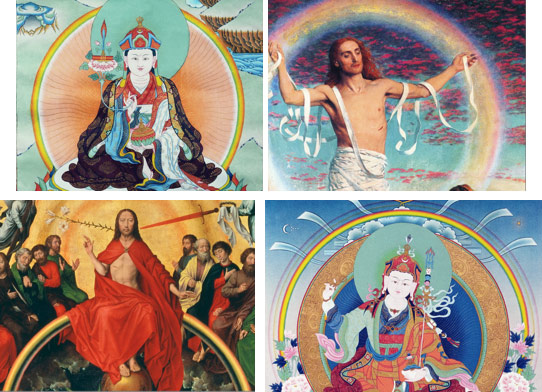
A collection of icons comparing and interconnecting Jesus on the rainbow ring in Last Judgment art with Tibetan Rainbow Body of light art. As Isaiah 60:1 says, “Arise, shine; for thy light is come, and the glory of the Lord is risen upon thee.” I connect the glory that rises within us with the glowing rays (glow rays) of the Rainbow Body of light.
In light of my equation of the Rainbow Body of light with the higher frequency light body of the seraphim it makes perfect sense why Jesus would appear as an apparition of a seraphim to Francis
Interestingly, the word apparition means specter," from L. spectrum "appearance, image, apparition," from specere "to look at, view,” meaning "band of colors formed from a beam of light". One can only presume to imagine the ecstasy a holy man like Francis must have felt were he touched by the full-spectrum Rainbow Light Body/Resurrection Body of Jesus.
THE SERAPHIM AND THE THRONE OF GOD
The six ‘wings’ of the seraphim also corresponds with the six points of the Merkaba “chariot” of Jewish mysticism. According to the verses in Ezekiel and its attendant commentaries, the analogy of the Merkaba image consists of a chariot made of many angels being driven by the "Likeness of a Man.
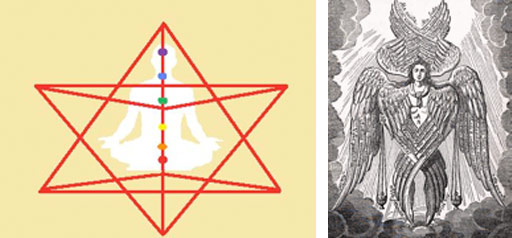
The six points of the Merkaba throne correspond to the six wings of the seraphim
Four angels form the basic structure of the Divine Throne
These angels are called the living creatures. Their bodies are like that of a human being, but each of them has four faces, corresponding to the four directions the chariot can go (north, east south and west). The faces are that of a man, a lion, an ox and an eagle. The seraphim as the four angels make their most memorable appearances in the visions of Ezekiel (1:4-28, 10:3-22), Isaiah (6:2-6), and Rev 4:6-8:
And before the throne there was a sea of glass, and in the center and around the throne, four living creatures full of eyes in front and behind. The first creature was like a lion, and the second creature like a calf, and the third creature had a face like that of a man, and the fourth creature was like a flying eagle. Each of the four living creatures had six wings and were full of eyes inside and out. Without stopping day or night they were saying, Holy, holy, holy is the Lord God Almighty, who was, who is, and who is coming very soon.
This 13th century illumination shows the four living creatures surrounding Jesus on the Divine Throne/Chariot. He is in a vesica shape, which indicates a portal or gateway. In SOUL RISING, I discuss the possibility that Jesus does not stay ‘parked’ on the Throne all the time. Instead, he travels through it, even coming to earth. In his vision of the apparition of Jesus as a seraphim, Francis describes the Divine Throne.
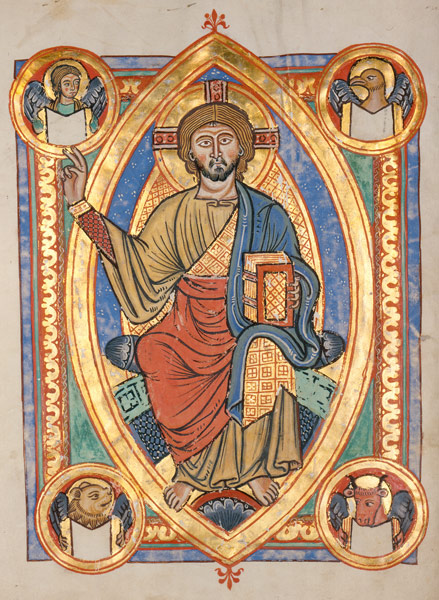
Jesus in the almond-shaped gateway and riding upon the Divine Throne/Chariot
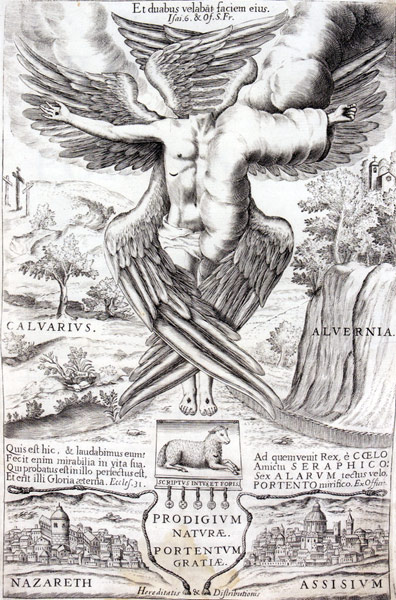
Franics as a seraphim. Frontispice, Pedro de Alva y Astorga, Naturae Prodigium Gratiae Portentum (Prodigy of Nature, Portent of Grace), Madrid, 1651. The Lilly Library, Indiana University. Bernardo Mendel Collection
The book for which this print serves as a frontispiece is one of the most important works elaborating the mystical concept of Saint Francis as a second Christ. A hybrid being with two wings hiding its face is presented in this image. The left half is Christ, and the right half is Saint Francis. In the background on the left, Nazareth and Calvary symbolize the beginning and end of Jesus’s life. On the right half we find Assisi and Alverna, the birthplace of Francis and the place where he experienced the Seraphic Ecstacy and transformation through the stigmata. Above the view of Assisi is the inscription from the Office of Saint Francis: “To whom the King came, seraphically clothed from heaven: covered by a veil of six wings, a miraculous portent.”
THE GENTLE HEART
While reading Sills’ Parabola article I experienced a wonderful synchronicity. I kept jumping to a page featuring the exquisite Bhutanese painted Thanka below of a Buddha achieving the Rainbow Body of light. Each time I turned to the painting I wondered what happened to the rest of the article about Francis? The third time I did it I realized this image was part of an article called GENTLE HEART, a story about the Buddha encountering a woman named Gentle Heart.
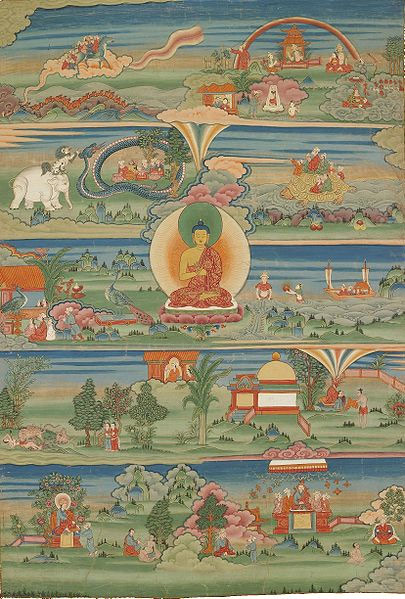
Bhutanese painted thanka of the Jataka Tales, 18th-19th century, Phajoding Gonpa, Thimphu, Bhutan
Reading between the pages of Parabola, I received confirmation, or maybe encouragement, to continue linking the seraphim and the Rainbow Body of light.
Francis certainly lived the way of the gentle heart, the way of the Buddha. In my view, his desire, coupled with his reflection on the true love of Christ, tuned his soul to a faster, gentler vibration, one that could have put him at an ecstatic frequency in which he could received, humbly, the golden rays of a gentle, loving seraphim. It is this vibration that permeates the air and soil of Assisi. I can’t wait to return.
0





No comments:
Post a Comment